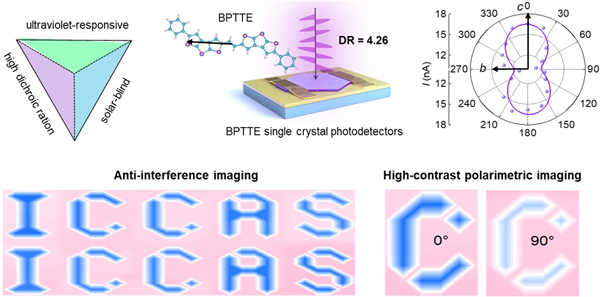Researchers Develop Highly-Polarized Solar-Blind Ultraviolet OrganicPhotodetectors
DONG Huanli lab from the Institute of Chemistry of the Chinese Academy of Sciences (ICCAS) has developed highly-polarized solar-blind ultraviolet photodetectors with organic polarized optoelectronic materials and devices.
Polarization-sensitive solar-blind photodetectors (PSSBPDs), a type of photodetector that can detect light in the ultraviolet (UV) range, serve as a complement to visible and infrared detectors, with wide-ranging applications in remote sensing, analytical imaging, information encryption, anti-counterfeiting, bio-inspired navigation, and more. Compared to traditional optical communication systems, solar-blind optical communication systems exhibit characteristics of high signal-to-noise ratio and interference resistance due to UV light propagation and its strong atmospheric ozone absorption, highlighting their significant scientific and technological importance. Moreover, organic semiconductors with advantages such as molecular designability and flexibility, which are promising for flexible optoelectronics, would be ideal candidates for PSSBPDs.
In this study, researchers focused on the unique twisted molecular conformation of trans-1,2-bis(5-phenylthiophen-2-yl)ethylene (BPTTE), chosen for its high charge mobility and wide bandgap characteristics.
The molecular structure of BPTTE allows for efficient charge transport while exhibiting a wide bandgap (3.1 eV) with solar-blind absorption properties. The molecular transition dipole moments along the b-axis direction cancel each other out within the BPTTE unit cell, totaling 0 Debye, as derived from single crystal data and theoretical calculations. This indicates significant intrinsic anisotropy and strong anisotropic light absorption properties within the bc crystal plane.
The potential application of BPTTE molecular crystals in PSSBPDs is suggested due to their high absorption anisotropy and strong absorption characteristics in the UV and solar-blind spectrum. The polarization sensitivity ratio of the photodetector based on BPTTE single crystals reaches as high as 4.26, one of the highest values among current organic polarization-sensitive ultraviolet light detectors. Under voltage modulation, the photodetector constructed with BPTTE single crystals as the core functional layer demonstrated efficient and stable detection of polarized ultraviolet light. Finally, the BPTTE single crystal photodetector successfully demonstrated high-contrast polarization imaging and interference-resistant imaging, highlighting the potential of organic semiconductors in the field of polarization-sensitive solar-blind light detectors.
This work was recently published in Advanced Materials. This study was supported by the National Natural Science Foundation and the Ministry of Science and Technology.

Highly-polarized solar-blind photodetectors and the polarization and anti-interference imaging demonstrations. (Image by ZHANG Yu)
Contact:
Prof. DONG Huanli
Institute of Chemistry, Chinese Academy of Sciences
Email: dhl522@iccas.ac.cn





